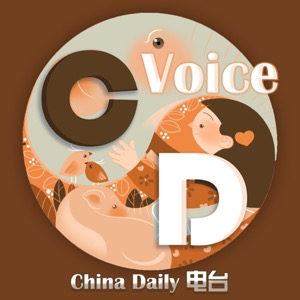英语新闻丨China ranks 2nd in STEM education
CD Voice - A podcast by China Daily

China ranks second globally in STEM education development, trailing only the United States, according to a new index released on Sunday by the Tongji University STEM Education think tank in Shanghai. 上海同济大学 STEM 教育智库周日发布的一项新指数显示,中国在 STEM 教育发展方面位居全球第二,仅次于美国。 The Global STEM Education Development Index 2025, billed as the world's first comprehensive evaluation tool for national and regional science, technology, engineering and mathematics education development, placed the US in the top position with 86.50 points. China followed closely with 85.46 points. Switzerland, Singapore and Denmark rounded out the top five countries. 《2025 全球 STEM 教育发展指数》被誉为全球首个针对国家和地区科学、技术、工程与数学教育发展的综合评估工具。该指数中,美国以 86.50 分位居榜首,中国以 85.46 分紧随其后,瑞士、新加坡和丹麦跻身前五。 The index, developed with academic guidance from the Chinese Society of Educational Development Strategy and data from Elsevier, systematically assessed the STEM education development levels of 40 major countries and regions worldwide. It established 22 indicators across three dimensions: policy and resources, educational processes, and outcomes and impacts, aiming to provide a scientific benchmark for optimizing national STEM education strategies.该指数在全国教育发展战略学会的学术指导下编制,数据来源于爱思唯尔(Elsevier),系统评估了全球 40 个主要国家和地区的 STEM 教育发展水平。指数从政策与资源、教育过程、成果与影响三个维度设置了 22 项指标,旨在为优化各国 STEM 教育战略提供科学基准。 A representative from Tongji University highlighted the increasing global technological competition, stating that STEM education has become a core pillar supporting national innovation capacity and high-quality development. 同济大学一位代表强调,全球科技竞争日益激烈,STEM 教育已成为支撑国家创新能力和高质量发展的核心支柱。 The release of the index is a direct response to a guideline jointly published in January by the Central Committee of the Communist Party of China and the State Council, which called for deepening international STEM education cooperation and creating internationally influential indexes and reports. 该指数的发布是对今年 1 月中共中央、国务院联合印发的一份指导意见的直接响应,意见中呼吁深化 STEM 教育国际合作,打造具有国际影响力的指数和报告。 Further underscoring international recognition of China's STEM practices is the establishment of UNESCO's first Category 1 Center outside Europe and North America — the International Institute for STEM Education — in Shanghai. 联合国教科文组织在上海设立了国际 STEM 教育研究所,这是该组织在欧美以外地区设立的首个一类中心,进一步彰显了国际社会对中国 STEM 教育实践的认可。 The US' top ranking was attributed to its strong institutional and resource advantages, particularly in education funding as a percentage of GDP, its per-student expenditure and abundant education resources. 美国之所以位居榜首,得益于其强大的制度和资源优势,尤其是在教育经费占 GDP 比例、生均教育支出以及丰富的教育资源方面。 China, despite a relative gap in per capita resources, excelled in the "educational processes"dimension. Its outstanding performance in teachers' STEM competency scores, results from the Programme for International Student Assessment, or PISA, competition achievements and large-scale STEM graduate output helped offset these resource disparities. 中国尽管在人均资源方面存在相对差距,但在 “教育过程” 维度表现突出。其在教师 STEM 能力评分、国际学生评估项目(PISA)成绩、竞赛成果以及大规模 STEM 毕业生输出等方面的优异表现,弥补了这些资源差距。 Among emerging economies, India produced the world's largest number of STEM graduates at 3.34 million. However, its per-student funding amounted to only 17 percent of US levels, leading to a lower overall ranking of 30th place. 在新兴经济体中,印度的 STEM 毕业生数量全球最多,达 334 万人。但该国生均教育经费仅为美国的 17%,导致其总体排名较低,位列第 30 位。 The report emphasized that high proportions of education funding in GDP and per-student expenditure provide ample hardware support for research and teaching, fostering a virtuous cycle between basic research and talent cultivation. It also validated the significant impact of industry-academia-research collaboration and open international cooperation on the efficiency of STEM research output translation. 报告强调,教育经费占 GDP 比例高、生均教育支出高,能为科研和教学提供充足的硬件支持,促进基础研究与人才培养之间的良性循环。报告还证实,产学研合作以及开放的国际合作对 STEM 研究成果转化效率具有显著影响。 In past international assessments, Chinese students have demonstrated strong performance. The 2018 PISA, hosted every three years by the Organization for Economic Cooperation and Development, found that 15-year-olds in Beijing, Shanghai and the provinces of Jiangsu and Zhejiang ranked No 1 in all three core subjects — reading, science and mathematics — achieving the highest Level 4 rating. While China did not participate in the 2022 PISA test, it has consistently been among the top scorers. 在过去的国际评估中,中国学生表现优异。经济合作与发展组织每三年举办一次 PISA 测试,2018 年的测试显示,北京、上海、江苏、浙江的 15 岁学生在阅读、科学、数学三个核心科目中均排名第一,达到最高的 4 级水平。尽管中国未参加 2022 年 PISA 测试,但此前一直位居高分行列。 Domestically, China is prioritizing AI education. A recent document issued by the Ministry of Education outlines a tiered AI education system covering all levels of primary and secondary education. The system will guide students from basic cognitive understanding in primary school to deeper analysis in middle school and applied innovation in high school. At the higher education level, the development of artificial intelligence education at universities has been a priority. 在国内,中国正优先发展人工智能教育。教育部近期发布的一份文件规划了覆盖中小学各学段的分级人工智能教育体系。该体系将引导学生在小学阶段形成基础认知,初中阶段进行深入分析,高中阶段开展应用创新。在高等教育层面,高校人工智能教育的发展已成为重点。 Since 2018, when the first 35 Chinese universities introduced undergraduate AI programs, the field has expanded significantly, with over 626 institutions nationwide now offering AI-related degrees. 自 2018 年中国首批 35 所高校开设人工智能本科专业以来,该领域发展显著,目前全国已有 626 所院校开设人工智能相关专业。 STEM /stem/ 科学(Science)、技术(Technology)、工程(Engineering)、数学(Mathematics)的缩写 index /ˈɪndeks/ 指数,指标 competency /ˈkɒmpɪtənsi/ 能力,胜任力 collaboration /kəˌlæbəˈreɪʃn/ 合作,协作
